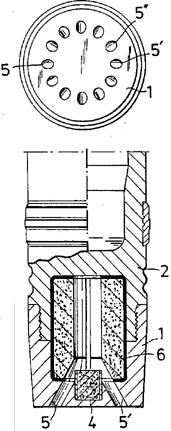Base bleed
Base bleed is a system used on some artillery shells to increase their range, typically by about 30%.
Most of the drag on an artillery shell comes from the nose of the shell, as it pushes the air out of its way at supersonic speeds. Shaping the shell properly can reduce this greatly. However, another powerful source of drag is the vacuum left behind the shell due to its blunt base. This drag is difficult to remove, because the shell needs to be "nose heavy" in order to have proper ballistics, and it cannot easily be shaped into a more aerodynamic form.
Base bleed is one way to reduce this drag without extending the base of the shell. Instead, a small ring of metal extends just past the base, and the area in the rear of the shell is filled with a small gas generator. The gas generator provides little net thrust, but simply fills the area behind the shell with pressure, dramatically reducing the drag due to the vacuum. The only downsides are a small loss of accuracy due to the somewhat more turbulent airflow, and a small loss in explosive payload due to some of the shell being taken up by the engine.
Since base bleed extends the range by a percentage, it is only really useful on longer range artillery. Until recently the loss in explosive was not considered worthwhile for the small gains in range. However, the introduction of much longer range systems based on the GC-45 howitzer has changed the equation somewhat, as 30% extra range on these systems represents 5 to 10km. Base bleed shells are starting to become more common in units equipped with modern artillery of this type.
The field was largely pioneered by the assassinated Canadian engineer Gerald Bull.
